The list of artificial reefs in Louisiana for speckled trout and redfish is what you'll find here. After that, I'll provide some additional fishing tips you may find useful about them. But who am I?
Hi, my name is Devin and I'm a former fishing guide and lifelong inshore angler.
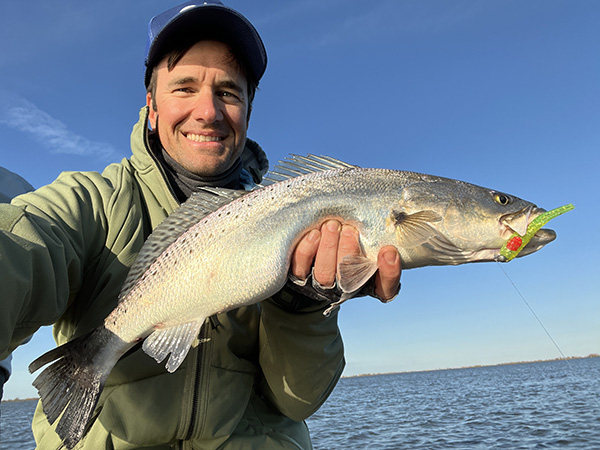
I've been fishing artificial reefs in Louisiana for years and realized that there really isn't a comprehensive list of Louisiana's man-made fishing spots one can easily access. I've also included reefs that aren't mentioned elsewhere.
So I'm putting them here! Use the jump menu below if it suits you:
An Important Note
The below list is for inshore fishing only. I'm not including offshore artificial reefs because that's not my thing. I don't offshore fish and am not particularly interested in it. I prefer inshore species like speckled trout, redfish (especially sight fishing for them), black drum, sheepshead and even triple tail.
So, if you're looking for offshore coordinates, then jump here to see additional resources to point you in that direction.
Complete List of Louisiana's Artificial Reefs for Speckled Trout & Redfish (east of the Mississippi River)
The following artificial reefs in Louisiana consist of limestone, crushed concrete, shells and/or reef balls. They all vary and you will ultimately know what they are when you snag them or see them on sonar.
Reef Name | Coordinates | Body of Water |
|---|---|---|
Cabbage Reef | 30˚ 07.990’ N 89˚ 14.825’ W | Mississippi Sound |
Grand Banks Reef | 30˚ 08.834’ N 89˚ 22.862’ W | Mississippi Sound |
Lake Borgne Shell Pad | 30˚ 04.283’ N 89˚ 35.107’ W | Lake Borgne |
West Karako Bay Reef | 30˚ 01.000’ N 89˚ 16.484’ W | East Biloxi Marsh |
Laketown | 30˚ 02.633’ N 90˚ 14.362’ W | South Lake Pontchartrain |
South Shore 1 | 30˚ 05.028’ N 90˚ 12.096’ W | South Lake Pontchartrain |
South Shore 2 | 30˚ 05.034’ N 90˚ 12.582’ W | South Lake Pontchartrain |
South Shore 3 | 30˚ 05.274’ N 90˚ 12.336’ W | South Lake Pontchartrain |
Lake Front | 30˚ 03.521’ N 89˚ 59.608’ W | South Lake Pontchartrain |
Orleans Reef | 30˚ 07.455’ N 90˚ 04.703’ W | Central Lake Pontchartrain |
South Twin Span | 30˚ 10.169’ N 89˚ 50.744’ W | East Lake Pontchartrain |
St. Charles | 30˚ 08.077’ N 90˚ 19.048’ W | West Lake Pontchartrain |
West End Pier | 30˚ 01.849’ N 90˚ 07.227’ W | South Lake Pontchartrain |
North Shore | 30˚ 16.296’ N 90˚ 03.753’ W | North Lake Pontchartrain |
North Twin Span | 30˚ 11.618’ N 89˚ 50.219’ W | East Lake Pontchartrain |
St. Tammany (east) | 30˚ 13.456’ N 89˚ 56.838’ W | North Lake Pontchartrain |
St. Tammany (west) | 30˚ 18.348’ N 90˚ 09.000’ W | North Lake Pontchartrain |
St. Tammany Pier | 30˚ 12.408’ N 89˚ 48.961’ W | East Lake Pontchartrain |
St. Charles | 30˚ 08.077’ N 90˚ 19.048’ W | West Lake Pontchartrain |
St. John Reef | 30˚ 05.832’ N 90˚ 24.276’ W | West Lake Pontchartrain |
California Point | 29˚ 29.024’ N 89˚ 29.049’ W | Breton Sound |
Artificial Reefs for Speckled Trout & Redfish West of the Mississippi River
The artificial reefs in Louisiana listed here are largely in the Barataria Basin area. If you're looking for the west side of the state or Vermilion Bay, then keep scrolling. After that, these have various construction methods that include limestone, crushed concrete, shells and reef balls. Be sure to scroll to the end of the guide to get those additional fishing tips I've got for you!
Reef Name | Coordinates | Body of Water |
|---|---|---|
Bodwin's Point | 29˚ 04.152’ N 90˚ 44.156’ W | Lake Pelto |
Hackberry | 29˚ 25.010’ N 90˚ 01.067’ W | Barataria Bay |
Hotel Sid | 29˚ 19.855’ N 89˚ 58.189’ W | Barataria Bay |
Pelican Island Reef | 29˚ 09.202’ N 90˚ 20.995’ W | Timbalier Bay |
Bird Island | 29˚ 03.560’ N 90˚ 43.430’ W | Lake Pelto |
Point Mast | 29˚ 06.444’ N 90˚ 38.143’ W | Lake Pelto |
Independence Island | 29˚ 18.450’ N 89˚ 56.002’ W | Barataria Bay |
Bay Ronquille Reef | 29˚ 20.010’ N 89˚ 50.587’ W | Bay Ronquille |
Artificial Reefs in Louisiana for Speckled Trout & Redfish in Vermilion Bay
Reef Name | Coordinates | Body of Water |
|---|---|---|
Cypremort Point 1 | 29˚ 43.333’ N 91˚ 52.367’ W | East Vermilion Bay |
Cypremort Point 2 | 29˚ 44.328’ N 91˚ 52.764’ W | East Vermilion Bay |
Prien Point | 29˚ 39.638’ N 92˚ 07.949’ W | West Vermilion Bay |
Redfish Pointe 1 | 29˚ 40.675’ N 92˚ 07.108’ W | West Vermilion Bay |
Redfish Pointe 2 | 29˚ 40.617’ N 92˚ 07.083’ W | West Vermilion Bay |
Rabbit Island Reef | 29˚ 30.567’ N 91˚ 33.867’ W | Cote Blanche Bay |
Artificial Reefs for Speckled Trout & Redfish in Lake Calcasieu (aka Big Lake)
Reef Name | Coordinates | Body of Water |
|---|---|---|
Finfish Reef 1 | 29˚ 58.140’ N 93˚ 18.062’ W | Lake Calcasieu |
Sweet Lake | 29˚ 56.514’ N 93˚ 17.415’ W | Lake Calcasieu |
Turner's Bay Island | 30˚ 03.326’ N 93˚ 18.470’ W | Lake Calcasieu |
Additional Tips For Fishing Louisiana's Artificial Reefs
Earlier I mentioned additional tips for fishing these artificial reefs in Louisiana and I'd like to include them here. These are things I learned over the years catching speckled trout, redfish, white trout and more at these locations and — if I had known them from the get go — my experience would have gone a lot smoother.
Let's start with how these sites are marked.
Marking of Artificial Reefs
The material that's used to build these sites sits well beneath the surface. It's not like the Trestles or rigs in Breton Sound that stick out above the water and are easy to see miles away.
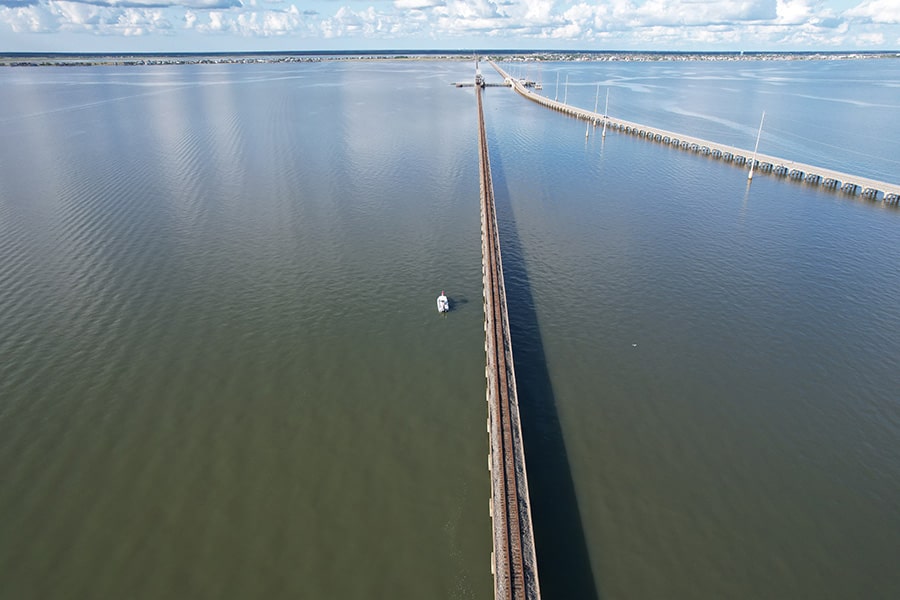
These fishing locations are easy to locate on a map or in person. Artificial reefs are not.
When you arrive to artificial reefs in Louisiana there will usually be nothing to let you know it's there. This is why your GPS coordinates must be spot on and you must accurately enter them into your boat's GPS unit.
In my experience, the provided coordinates are usually accurate and enough to get you close, but keep in mind that the reef itself may be as large as a football field (or larger) and that fish can be holding on one end and not the other. It will be up to you to move around to find the fish.
It's also worth noting that base maps on popular GPS units tend to have these locations marked. Check yours to be sure.
Sonar is gonna help out a lot...
A tool that really helps with find these reefs is sonar, especially side imaging sonar. This helps me find artificial reefs in Louisiana, see how they're laid out and whether there are fish and/or bait balls on it to be worth casting a line. For example, see the California Point Reef below.
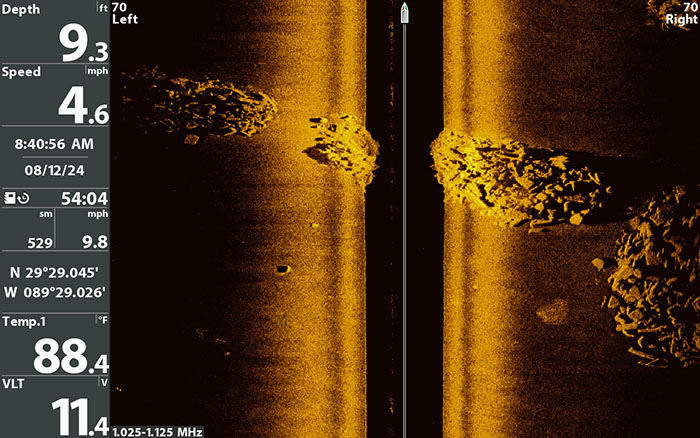
Here you can see the California Point Reef. It is composed of piles of concrete rubble.
But some reefs are composed mostly of "reef balls", like what you see below on an artificial reef somewhere in Lake Pontchartrain.
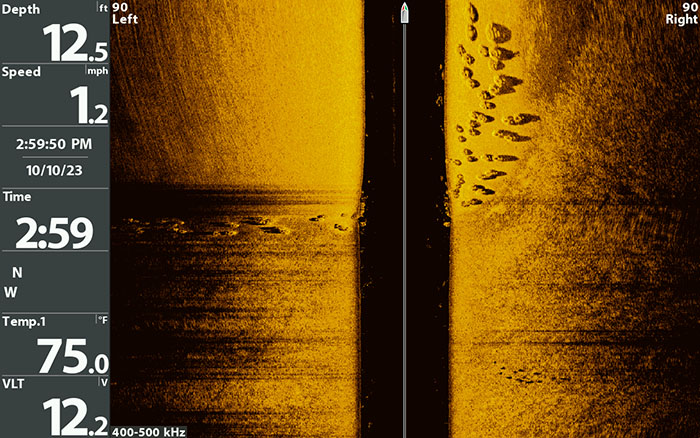
You can see that they look kind of like a "donut" because they are round with an exposed hole at the top. See the close-up I edited below. It gives a good idea as to what most artificial reefs in Louisiana look like.
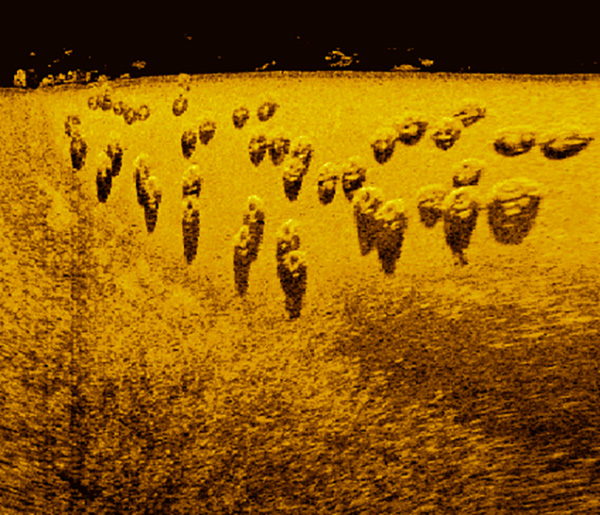
In fact, what sonar detects above is what I like to see! A hard bottom, reef balls and happy bait balls floating about. That's definitely worth casting a line on!
For comparison, below is a reef ball deployed underwater with divers. This way you can get a feel for how big these things are. No, obviously this photo was not taken on artificial reefs in Louisiana (there's always one who's going to ask LOL).
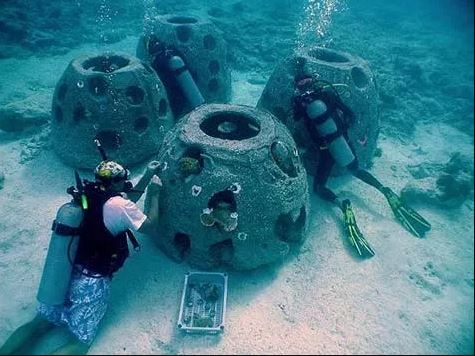
Are these man-made reefs marked at all?
Yes, some are. You may or may not see something like a white buoy marking the center of the reef. I generally don't trust these because tropical storms and hurricanes can drag them off-target. I've seen this happen and, when it does, anglers will fish where the buoy is and proceed to catch nothing.
This is why using GPS and sonar — indispensable tools for inshore anglers — is so crucial.
Sometimes I've seen artificial reefs in Louisiana marked by other contrivances. One time I saw Cabbage Reef marked on each corner by blue 5-gallon buckets. I'm not sure if they're still there or not.
Best Tackle & Technique For Fishing Louisiana's Artificial Reefs
Most of these reefs tend to sit in water that is 10ft deep or more. For the most part, this automatically rules out popping corks because they won't achieve good presentations. Instead, what I use and recommend that you use are jigs on casting tackle or Heavy Drop Shots on spinning tackle.
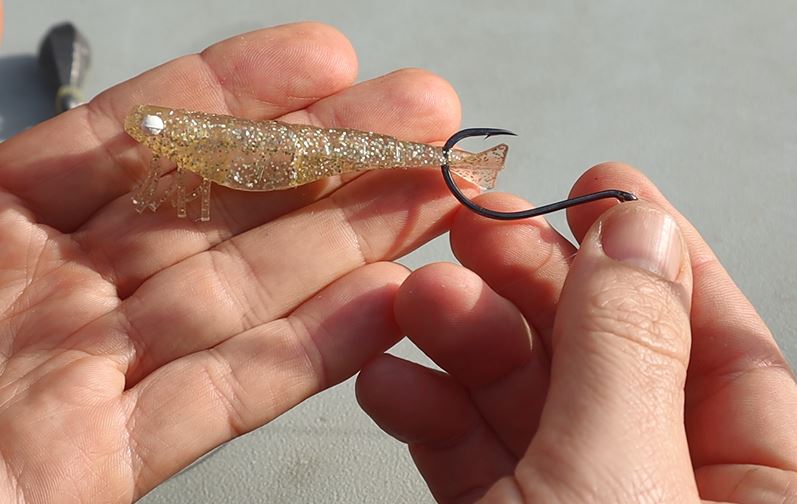
The Heavy Drop Shot is a good choice when fishing deep if all you are comfortable with is spinning tackle.
If you're not familiar with jigging, then you really need to check out my ultimate guide to jigging speckled trout. I personally feel that it is, hands down, the best way to achieve presentations to fish, especially in deeper and faster moving water like what you see on artificial reefs in Louisiana. The Achilles Heel of jigging is that it requires more angling skill and specific tackle up front. Not everyone has a good casting combo on hand and, even if they do, they don't really understand how to work it.
That's why, for spinning tackle die-hards, I recommend fielding a Heavy Drop Shot. I you've never heard of it, then you should really consider this guide to tying one.
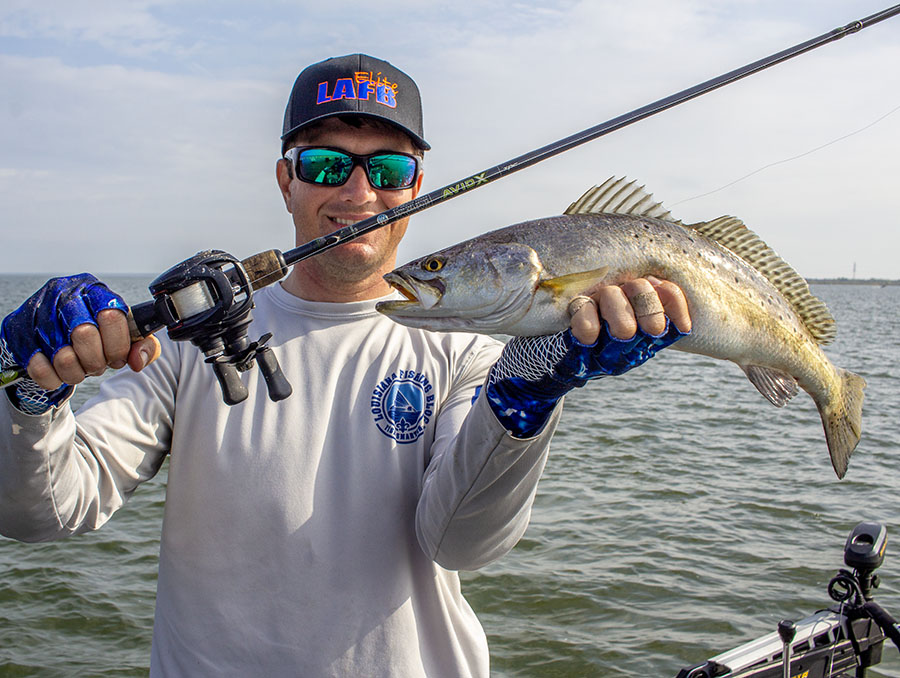
Jigging is my preferred method for taking speckled trout in deeper water, but the Heavy Drop Shot works well, too.
In the event this happens, you will want to have a tripping line set up to recover your anchor.
As an additional note, you do not need live bait for these many reasons when fishing these reefs. It's just unnecessary and I've caught fish on them using "artificial" lures year-round.
Finally, if terms like "boat positioning" and "presentation" don't make sense to you, then I strongly recommend viewing my free video course on how to best achieve these. It's about 25 minutes long and completely free, no signup required.
The #1 Reason You Want To Fish Artificial Reefs
You really want to become savvy fishing these hot-spots because they're intimidating to most inshore anglers. People have a mental hang-up where they have to be able to see what they are casting to. Whether that's white poles marking oyster reefs or something obvious like the Long Rocks, they can't stand not seeing what they're supposed to be fishing.

No, this picture is not photoshopped.
If you can consistently find and fish artificial reefs in Louisiana then you will be a much better angler than the numbskulls fishing the same old spots like what you see above. In fact, for these reasons I strongly suggest not fishing community holes.
Do these reefs even attract fish to begin with?
Yes, these do. But, I cannot say that every man-made reef always produces fish, because that's not true. But when they do "turn on" — and if you take the time to check — you will be on fish that no one else knows about. That reward is worth the effort. When this happens, keep it to yourself.
After that, I've found that some reefs produce fish more often than others. I'm sure it has to do with their placement, composition and seasonality. For example, the reefs in west Lake Pontchartrain tend to produce redfish during summer more so than speckled trout. That's because speckled trout are in saltier water spawning during that time of year. If you've read my fact sheet about specks, then you already knew that.
Those reefs "turn on" in the same way the nearby powerlines do.
See How I Fish Artificial Reefs In Louisiana
You may already be familiar with my YouTube videos. If so, then you should know that in this one I am fishing at a man-made reef.
Now, where is this particular fishing spot? Well, that's for me to know and for you to find out. Sorry, no spoon feeding here.
But in that video you'll see the proof in the pudding for catching trout on artificial reefs in Louisiana: the fishing tips and advice mentioned above actually work. You'll see the jig in action, maybe even a little sonar, some commentary and — most important — not a single other boat.
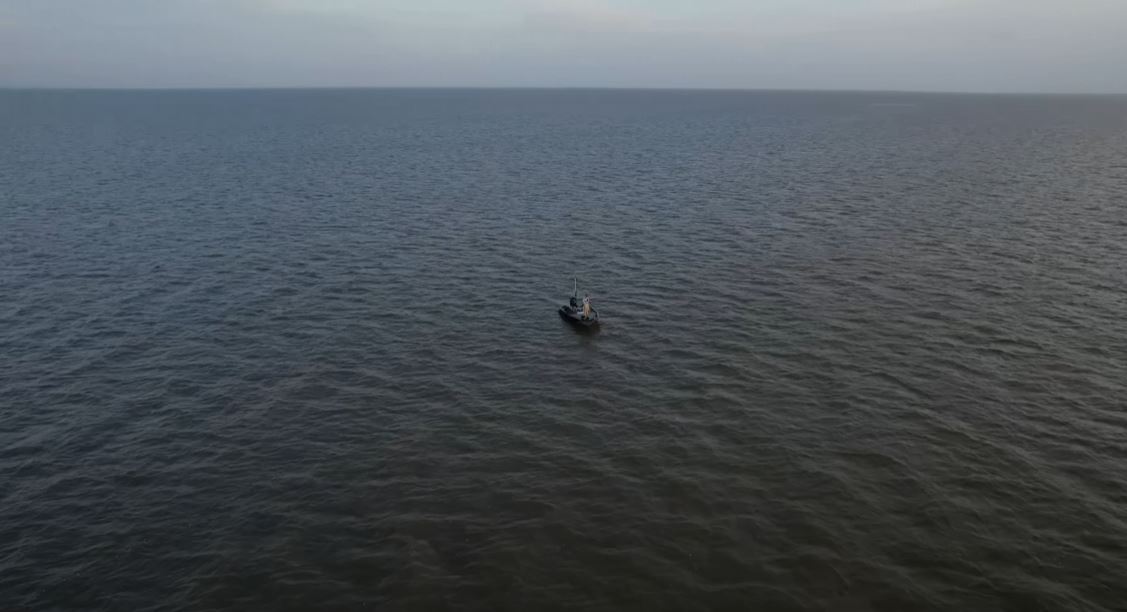
Do you see another boat here? Nope! Just me, catching a limit of fish all by myself without any extra pressure. Sure was fun!
Why is this the case?
Well, because I put in my time searching for fishing spots that are super productive and not pressured at all. The best thing you can do on any fishing trip you go on in your entire life is find biting fish in the first place.
That's what my course Inshore Fishing 101 is geared toward. In fact, that's what the majority of my content is about. Anyone trying to tell you that it boils down to buying their fishing lure, wielding a particular lure color or even exact fishing spots is lying to you. They're probably not catching fish on artificial reefs in Louisiana, but just the same spots over and over again, or wherever their buddies tell them to go. They truly don't understand how to find fish fish from scratch.
But I do. It's all about the process of finding biting fish in the first place, and that begins with fishing according to the conditions. That's the difference, and that's what I can teach you.
THANKS from a rookie inshore fisherman!!!
I really appreciate Devin's teaching & how he is "to the point" and down to earth, yet professional and gives a great presentation of what I need to know in order to catch speckled trout and redfish.
Before taking Inshore Fishing 101 I have not had very many successful trips to Louisiana, but with these great learning experiences, since completing 101, I have had more success. Finding the best conditions, using the right tackle, Google Earth Desktop & technical stuff on my Lowrance, etc., the list is too long for this, so THANKS from a rookie inshore fisherman!!!
Captain Devin has done an excellent job with these classes! As a speaker, preacher, college teacher, & singer I appreciate the research, experience, time, & knowledge he put into the great presentations of each class. I can not suggest any changes for such an excellent course!
Ira Burge
College Teacher
Learning The Technical Stuff Made Easy
I am horrible with GPS/computer interactions , so the building routes with Google was great. I can't wait to put in action to avoid shallow water and navigational hazards.
Something else I learned was fishing the entire water column, now I know what I was doing wrong and why I wasn't catching fish.
Inshore Fishing 101 is great because it is self paced, well organized and easy to navigate!
Shawn Bailey
Inshore Angler
Learned What I Needed To Know
One think I loved discovering inside Inshore Fishing 101 are the various tips and tricks to using Google Earth Desktop to find fishing spots.
I have used it a lot in the past but applying it the way Captain Devin demonstrates is great. I also loved the instruction on bait presentation and how to set up on a spot.
Jacob Ridgedell
Avid Outdoorsman
There's More: Get Help From Like-Minded Anglers
When you join my membership you gain instant access to LAFB Elite's Community, where members plan their fishing trips, post fishing reports and discuss all things related to inshore fishing in Louisiana. It's a great place to get help from folks who genuinely care, love fishing and won't give smartass answers like what you see on Facebook or elsewhere on the Internet.
It's a great way to get started fishing artificial reefs in Louisiana!
Or get my book...
I've since written Inshore Fishing 101 as a book available for purchase. It's titled Boot State Specks and you'll find it on Amazon.
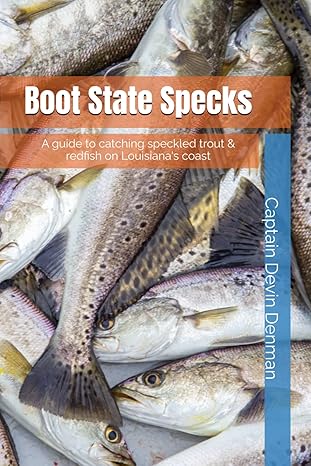
In it I cover artificial reefs and a slew of other fishing spots you want to try. Above all, it details my process for finding fish from scratch, safely navigating the marsh and achieving long term success in your fishing career.
Where To Get More Information Regarding Artificial Reefs in Louisiana
I already knew the coordinates and names of some of the reefs listed above because I've fished them a lot over the years. But there were some I am yet to be familiar with and I sourced those from this page on Louisiana Department of Wildlife & Fisheries' website.
It's also there you will find coordinates for offshore artificial reefs in Louisiana, as well as sponsor info and other meta you may find interesting.
Finally, when new reefs are installed, I assume the updates will be reflected on that page and then eventually this one. So be sure to bookmark both or subscribe to my newsletter so you don't miss out.

For example, at the time of this writing in May 2025, there is a new reef that has been installed off of Goose Point in Lake Pontchartrain, aptly named the "Goose Point Reef". But, according to this article, the coordinates are yet to be published.
However, we are working on that in this post inside LAFB Elite's Community. So, if you're a member, check there and see what updates we've got.
What do you think about artificial reefs in Louisiana?
Have you fished them before? Is there something I missed in this guide? I love it when people comment on my website, as it's a great way to let me know that you visited. I hope you found the information here useful and that it helps you enjoy more productive fishing trips!
Tight lines!

Great information, I enjoy this format and the open discussions
Thank you so much!
Great info as always
Thank you for visiting my website! If you have something to add, or a simple question, please post it here!